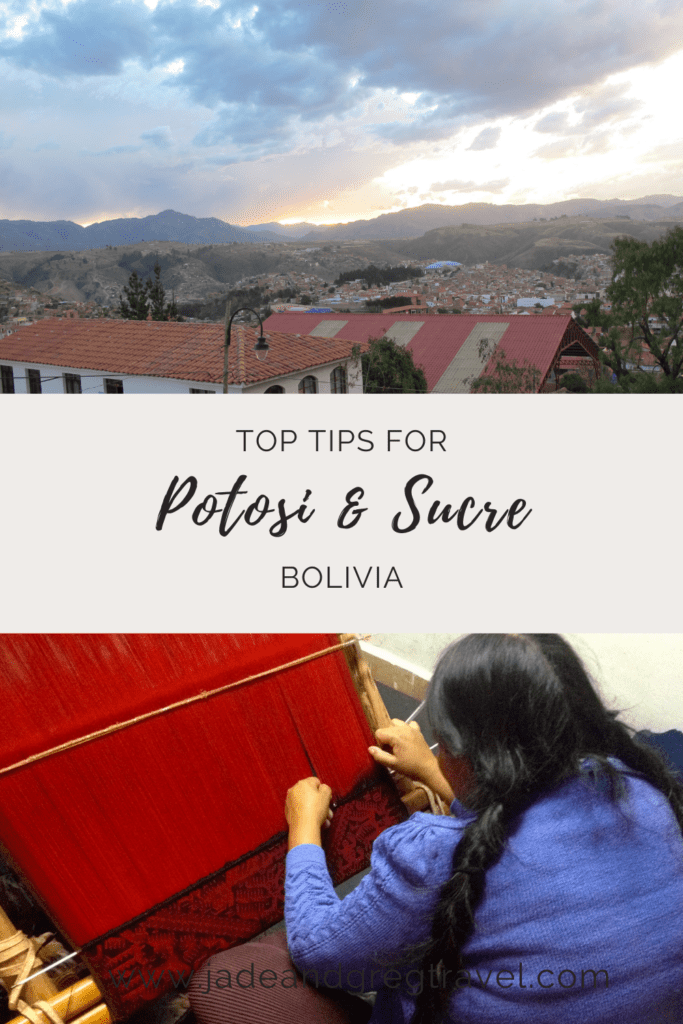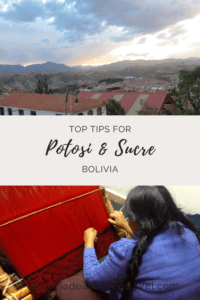
Hola! Estamos en Potosi y Sucre!
So off we went from english speaking guides and a big city to the depths of Bolivia where Spanish is the only language. We arrived in Potosi after a quick toilet stop in someones backyard (just squat in the field, girls on one side, boys on the other. Lots of peeking going on as well.)
Potosi is not really a tourist town, it is built around the famed plata (silver) mines in the nearby mountain Cerro Rico. While this does bring tourists in, there really aren’t many.
Cerro Rico and Cerro de Potosi was the main supply of silver for Spain during the New World Spanish Empire. Silver was mined and taken by llama and donkeys, then shipped to Panama and onwards to Spain. Many a fortune was made there and even today the mountain gives silver and iron ore. However Cerro Rico is filled with tunnels from miners, who follow a thread of silver straight through the mountain. The risk of the mountain collapsing is heightened every day. The miners pray to the god of Cerro Rico, El Tio, miners and tourists bring offerings for the god in the form of coca leaves, alcohol, orange fanta and cigarettes.
Whilst fascinating, we decided not to visit the mountain – risk of collapse firmly in our minds, the risk of asbestos poisoning (it also runs through the mountain!) and the uneasy feeling of meeting miners who expect gifts as this whole thing has a sideline as a tourist business.
Instead we took the time to explore this very hilly high altitude town. Walking around is huge exercise as the hills are steep and you are always short of breath from the altitude!
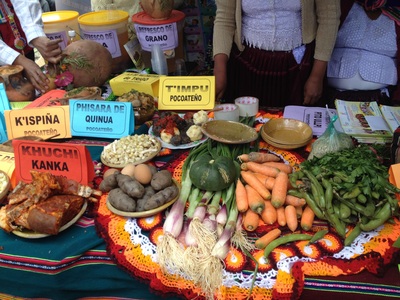
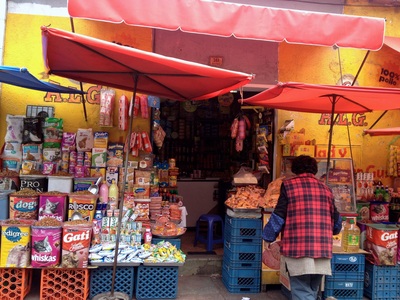
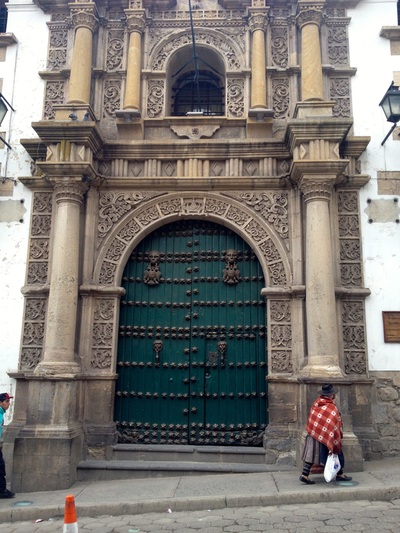
One highlight was a fantastic restaurant with the local speciality – kalaphurka also known as Volcano Soup. I convinced Greg to get a taxi way out in the middle of nowhere because I found this awesome restaurant on Tripadvisor. We went, we ate and it was AWESOME.
Bolivia is not known for its food, as its fairly bland. Just take quinoa the main staple. Not very flavoursome, nor tasty by itself. BUT the Kalaphurka was full of flavour. The dish is a like a mixed soup/hotpot where all sorts of unidentifiable vegetables, grains and meat are included. The restaurant only serves one dish, and if they run out there is one other soup dish. They recommend it to go with the sweet malt bolivian beer, I even didn’t mind it!
The kalaphurka comes in a special bowl and bubbles away as the last ingredient is the hot lava rock which creates the bubbling effect.
We wandered around Potosi, exploring and gradually increasing our spanish. Enjoying the markets, the fruit, meats and fresh produce. And stocking up on our pirated DVDs – which we made great use of on the rainy days.
Soon it was time to leave again! We got a fond farewell from our landlady, an older bolivian lady who only spoke spanish but tried really hard to bridge the language gap! She gave both of us huge hugs as we left in the taxi to the bus stop.
Whilst the road to Sucre was lovely and full of great views, our bus driver clearly had a death wish for all of us. We overtook cars (on a one lane highway), trucks, even the earlier bus, all blindly turning corners, on the wrong side of the road……we were shaking by the end!
We got to Bertha’s place in the afternoon and settled in. Bertha and Pepe, with their kids Matteo & Luciana, run an airbnb for their house in Sucre. It has 3 guest rooms, and a central courtyard, one communal, fun kitchen, a bathroom, and a dog. I was a little apprehensive not sure what to expect, but it was wonderful to meet other travellers and stay in this welcoming place – I highly recommend it!
We met Donia an aussie/german lady who was in Sucre for a few months to learn German, Pierre and Camille a french couple travelling over South America for a year!, and another US couple who left soon after we arrived. It was Sunday night and apparently that is communal dinner, so we chipped in and made a dish, along with special ‘galettes’ (cake treats) that we brought from Potosi. The atmosphere was warm and friendly, you really felt like a piece of home in Sucre.
Bertha runs a spanish school and we decided to sign up immediately – whilst our spanish learning app is ok, it doesn’t beat a teacher! Each morning we’d walk into town with Camille & Pierre, to go to spanish school. Greg and I would have a 4 hour class with our teacher Estella, and get a small break to run over the road and grab a saltena.
In the afternoons we wandered around the city, and even met an australian who runs the non-profit cafe/tour guides at Condor Trekkers. They even made proper coffee…my soy mocha was HEAVENLY!
Sucre is a beautiful white washed city, that has lovely french style gardens, buildings and large roads. The opposite of La Paz in every way. We went to the various museums, watched a Jal’qa tribeswoman weaving traditional cloth in the museum and saw a regional masks exhibit (scary masks!).
We even did a city tour with an english student at the local university. Sucre has played a great political role in Bolivian history. At one time it was the capital and many wealthy spanish bolivians lived here (hence the french style gardens, huge european mansions etc).
May 25, 1809 Bolivian indépendance started with the ringing of the bell at the Basilica of Saint Francisco which broke the huge bell and you can still see it today with a large crack running down its side. The decline of Potosi’s silver saw the seat of government move to La Paz in late 1800’s, while Sucre is still administrative government, there are still cries to move the capital back to Sucre. The university there is also one of the oldest in the new world, older than Harvard, it was established by the Spaniards in 1600 and is still educating students today.
On another note Miriam our guide told us about the Sucre tunnels, created hundreds of years ago and connecting all the churches. It is an entire network underfoot, most of which has been blocked because of rat infestation years ago. Now there are talks of opening it for tourists.
Our last spanish lesson was on a school trip to Castille de Glorietta, a country home for the Prince and Princess who owned it. An amazing mansion / mini castle, with beautiful grounds that are reminiscent of french gardens (not anymore though!).
Our highlights were wandering around the markets, sampling all the fresh fruit, buying vegetables and fresh meat for dinner. They have a whole section of fruit juice stalls where your favourite tropical fruit can be juiced!
We enjoyed the cultural differences for example Passionfruit, is not translated as Frutta de la Passion!
And there was chocolate tasting too!
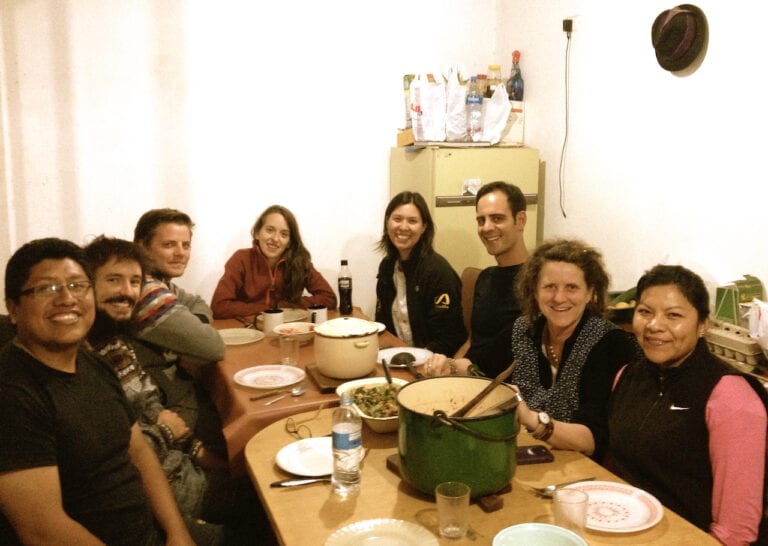
Our last night we had all the spanish teachers and students to Berthas home, we cooked (ok Greg did), and drank my favourite wine – vino dolce (sweet red spanish wine). At the airport there was a very long wait, and an old man befriended me and tried to sell me a cochanga guitar, I ended up getting him to play it – and he did so beautifully earning some tips!
Onwards to the jungle!
